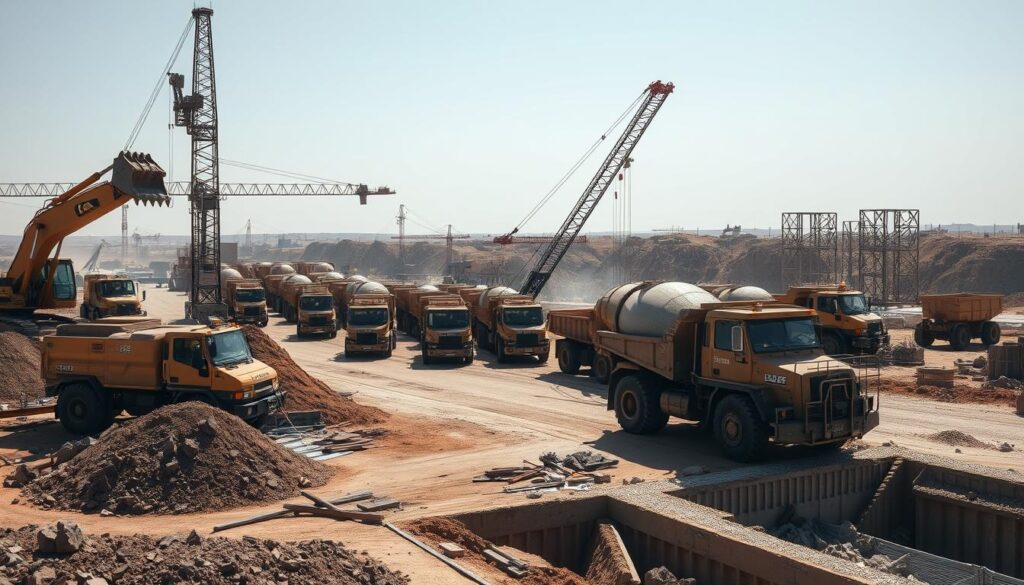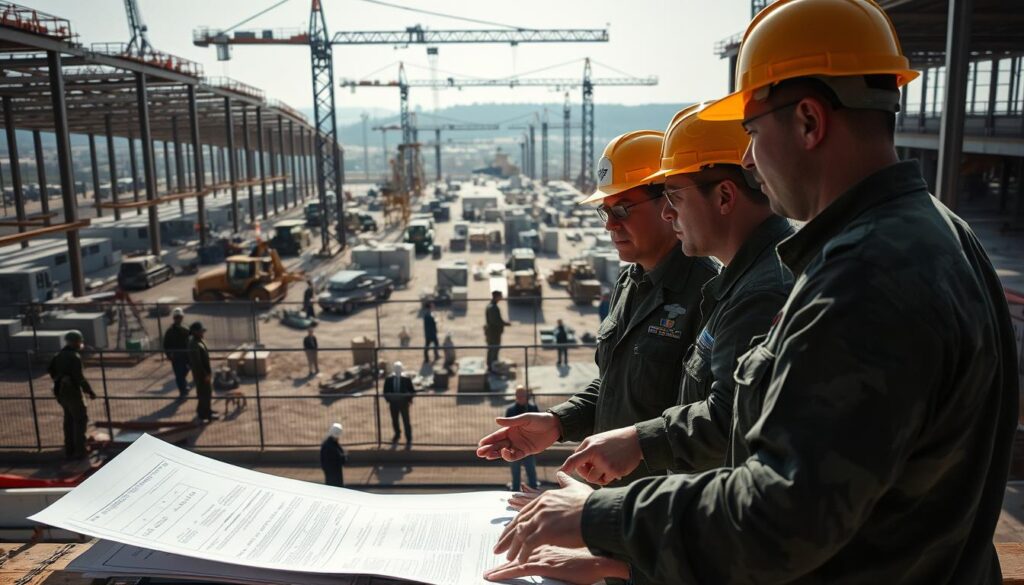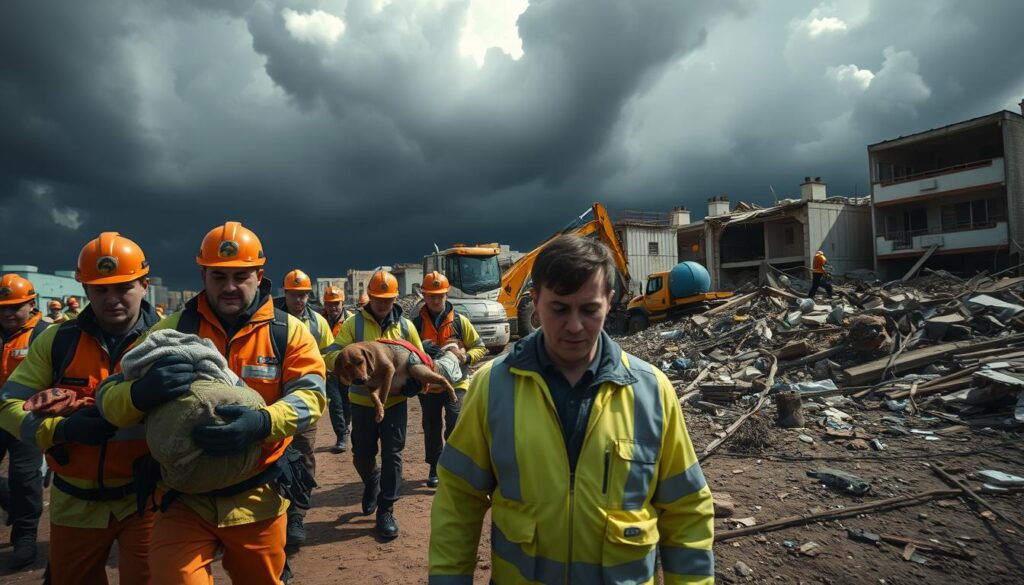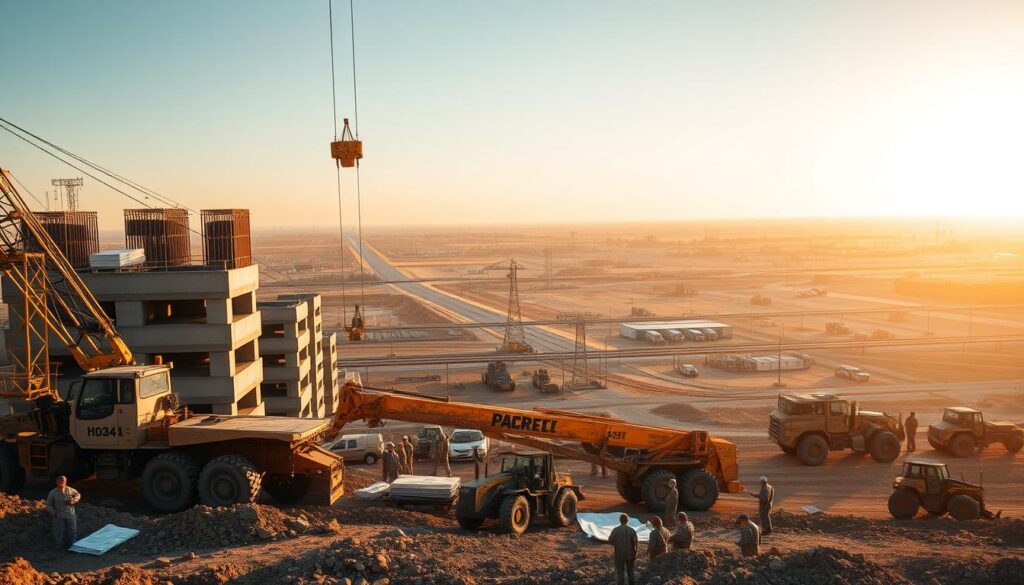The U.S. Armed Forces rely on the Civil Engineering Squadron to build and maintain critical infrastructure, supporting defense operations worldwide. With expertise in military construction, these specialized units play a vital role in ensuring the success of military projects.
Their capabilities extend to various aspects of infrastructure development, including construction services that are essential for military readiness. By providing high-quality civil engineering services, the squadron contributes significantly to the effectiveness of military operations.
Key Takeaways
- The Civil Engineering Squadron is crucial for military infrastructure development.
- They specialize in military construction projects.
- Their work supports defense operations globally.
- Civil engineering services are vital for military readiness.
- The squadron’s expertise ensures the success of military construction projects.
What Defines a Civil Engineering Squadron
Civil Engineering Squadrons are specialized units that bring engineering expertise to the forefront of military operations. These squadrons are crucial in supporting the infrastructure needs of military bases and forward operating locations.
Core Mission and Capabilities
The core mission of a Civil Engineering Squadron is to provide comprehensive engineering services, including construction management, facility maintenance, and emergency response capabilities. They are equipped to handle a wide range of tasks, from building and maintaining infrastructure to responding to natural disasters.
Differences from Civilian Engineering Teams
Unlike civilian engineering teams, Civil Engineering Squadrons are trained to operate in austere environments and under various conditions, including combat zones. Their capabilities extend beyond traditional engineering tasks to include expeditionary engineering and disaster response.
Integration with Military Operations
Civil Engineering Squadrons work closely with other military units to ensure that infrastructure supports operational needs. Their integration with military operations is critical for the success of various missions, providing air force engineering units with the necessary infrastructure to operate effectively.
In summary, Civil Engineering Squadrons play a vital role in military engineering, offering a unique blend of construction management, emergency response, and infrastructure development capabilities that are essential for military operations.
History and Evolution of Military Engineering Units
The evolution of military engineering units reflects the changing nature of warfare and construction needs. Over time, these units have adapted to new technologies, tactics, and operational requirements, playing a crucial role in military operations.
Origins of Military Construction Teams
Military construction teams have their roots in ancient times when armies first began constructing fortifications, roads, and bridges. These early engineering efforts were crucial for military mobility and defense. The Romans, for example, were renowned for their sophisticated engineering capabilities, including the construction of fortified camps and infrastructure that supported their expansive empire.
Development of Modern Engineering Squadrons
The modern concept of engineering squadrons developed significantly during the 20th century, particularly during World War II, when the need for rapid construction and repair of airfields, ports, and other critical infrastructure became paramount. This period saw the establishment of specialized units trained to operate in combat zones, undertaking tasks such as explosive ordnance disposal and rapid runway repair.
The development of modern engineering squadrons has continued to evolve, incorporating advanced technologies and techniques. Today, these units are equipped with state-of-the-art equipment and trained in a wide range of skills, from construction management to environmental remediation.
Milestone Projects Throughout History
Throughout history, military engineering units have been involved in numerous milestone projects. Some notable examples include:
- The construction of the Panama Canal, a major engineering feat that significantly impacted global trade and military mobility.
- The development of forward operating bases in Iraq and Afghanistan, demonstrating the ability of modern engineering squadrons to establish complex infrastructure in challenging environments.
- The repair and reconstruction efforts following natural disasters, showcasing the versatility and humanitarian role of military engineering units.
These projects highlight the critical role that military engineering units play in both military operations and broader infrastructure development.
Organizational Structure of Civil Engineering Squadrons
Understanding the organizational structure of Civil Engineering Squadrons is essential for appreciating their role in military engineering. These squadrons are complex units with multiple specialized teams working together to achieve their mission.
Command Structure and Leadership Roles
The command structure of Civil Engineering Squadrons is designed to provide effective leadership and direction. Commanding Officers are responsible for strategic decisions, while senior enlisted leaders guide the enlisted personnel.
Specialized Teams and Their Functions
These squadrons comprise various specialized teams, each with distinct functions. For instance, the Engineering Flight handles project planning and execution, while the Contracting Office manages procurement and contracts.
| Team | Function |
|---|---|
| Engineering Flight | Project Planning and Execution |
| Contracting Office | Procurement and Contract Management |
| Readiness Flight | Base Readiness and Infrastructure Support |
Integration with Air Force Wing Operations
Civil Engineering Squadrons play a crucial role in supporting Air Force wing operations. They provide essential services that enable the wing to carry out its mission effectively.
Support for Flying Missions
These squadrons ensure that airfields and related infrastructure are maintained and ready for use. This includes airfield lighting, runway maintenance, and other critical tasks.
Base Readiness Responsibilities
They are also responsible for overall base readiness, including infrastructure maintenance and emergency response planning.

Military Construction Projects and Capabilities
The versatility of Civil Engineering Squadrons is evident in their wide range of military construction projects and capabilities. These units are fundamental to the development and maintenance of military infrastructure, ensuring that facilities are operational and meet the needs of military personnel.
Airfield Construction and Maintenance
Airfield construction and maintenance are critical functions of Civil Engineering Squadrons. They are responsible for building and maintaining runways, taxiways, and aprons, as well as ensuring that airfield lighting and navigation aids are operational. This involves heavy construction equipment and specialized techniques to meet stringent military standards.
Military Facility Development
Military facility development encompasses a broad range of projects, including the construction of barracks, administrative buildings, and other facilities necessary for military operations. Civil Engineering Squadrons work to ensure that these facilities are designed and built to meet the specific needs of the military, incorporating sustainable practices where possible.
Infrastructure Systems Installation
Infrastructure systems installation is a vital aspect of military construction, involving the setup of essential services such as power generation and distribution, water and sanitation systems, and communication infrastructure.
Power Generation and Distribution
Civil Engineering Squadrons are responsible for installing and maintaining power generation and distribution systems. This includes setting up generators, transformers, and electrical grids to ensure a reliable power supply for military facilities.
Water and Sanitation Systems
The installation of water and sanitation systems is another critical task. These systems are essential for providing clean water and proper waste management, contributing to the health and well-being of military personnel.
Communication Infrastructure
Communication infrastructure is vital for military operations, enabling effective command and control. Civil Engineering Squadrons install and maintain communication networks, including fiber optic cables, antennas, and other necessary equipment.
The capabilities of Civil Engineering Squadrons in military construction projects are diverse and critical to military readiness. Their work ensures that military facilities are operational, safe, and sustainable.
- Military construction projects are diverse and complex.
- Civil Engineering Squadrons play a crucial role in airfield construction and maintenance.
- Military facility development is a key aspect of their operations.
- Infrastructure systems installation is essential for military readiness.
Training and Expertise Requirements
To accomplish their mission, Civil Engineering Squadrons require personnel with specialized training and expertise. The demanding nature of their work necessitates a comprehensive training program that equips members with the necessary skills to handle various construction and engineering tasks.
Technical Training Programs
Civil Engineering Squadron members undergo rigorous technical training programs that focus on developing their skills in areas such as construction management, engineering, and project oversight. These programs are designed to ensure that personnel are proficient in the latest techniques and technologies used in military construction projects.
Professional Military Education
In addition to technical training, members of Civil Engineering Squadrons are also required to complete professional military education courses. These courses cover topics such as leadership, management, and military protocols, helping personnel to develop the skills needed to effectively lead and manage teams.
Certifications and Specialized Skills
Certifications and specialized skills are crucial for Civil Engineering Squadron members. Engineering credentials and construction management qualifications are highly valued, as they demonstrate a level of expertise and competence in specific areas.
Engineering Credentials
Engineering credentials, such as professional engineer licenses, are essential for many roles within Civil Engineering Squadrons. These credentials indicate that an individual has met specific standards of education, experience, and competence in their field.
Construction Management Qualifications
Construction management qualifications are also vital, as they demonstrate an individual’s ability to manage and oversee construction projects effectively. These qualifications often involve specialized training and certification in areas such as project management and construction supervision.

Expeditionary Engineering and Combat Support
Expeditionary engineering, a key aspect of combat support, is spearheaded by Civil Engineering Squadrons through their advanced capabilities and rapid response. These squadrons are crucial in enabling military operations in various environments and conditions.
Rapid Deployment Capabilities
Civil Engineering Squadrons are trained and equipped to deploy rapidly in response to emerging needs. Their rapid deployment capabilities allow them to establish a presence in challenging environments, providing essential infrastructure and support.
This capability is critical in supporting military operations, as it enables the swift establishment of operational bases and the provision of necessary services.
Forward Operating Base Development
The development of forward operating bases is a key function of Civil Engineering Squadrons. These bases serve as critical hubs for military operations, providing the necessary infrastructure for troops and equipment.
By establishing forward operating bases, Civil Engineering Squadrons enhance the military’s ability to project power and respond to threats effectively.
Contingency Response Operations
Civil Engineering Squadrons play a vital role in contingency response operations, providing the necessary engineering expertise to respond to emergencies and crises.
Airfield Damage Repair
One of the critical tasks undertaken by Civil Engineering Squadrons is airfield damage repair. This involves rapidly assessing and repairing damage to airfields to restore operational capability.
Emergency Infrastructure Restoration
In addition to airfield repair, these squadrons are also involved in emergency infrastructure restoration, ensuring that critical infrastructure is restored quickly to support ongoing operations.
By focusing on expeditionary engineering and combat support, Civil Engineering Squadrons demonstrate their versatility and critical role in modern military operations.
Equipment and Technology in Civil Engineering Squadron Operations
Civil Engineering Squadrons utilize cutting-edge technology and heavy machinery to support military operations. The right equipment is crucial for the success of their missions, ranging from construction and repair to disaster response and humanitarian aid.
Heavy Construction Equipment
Heavy construction equipment forms the backbone of a Civil Engineering Squadron’s capabilities. This includes:
- Excavators for digging and moving large amounts of soil
- Bulldozers for grading and clearing land
- Cranes for lifting heavy loads
- Dump trucks for transporting materials
These machines are essential for airfield construction, facility development, and infrastructure projects.

Specialized Military Engineering Vehicles
Beyond standard construction equipment, Civil Engineering Squadrons employ specialized military engineering vehicles designed for specific tasks and environments. These include:
- Bridge-laying tanks for rapid bridge deployment
- Combat earthmovers for digging and grading in combat zones
- Route clearing equipment for explosive ordnance disposal and road clearing
Survey and Design Technologies
Accurate surveying and design are critical for successful construction projects. Civil Engineering Squadrons use advanced technologies such as:
- GPS and GIS systems for precise mapping and data collection
- 3D modeling software for designing complex infrastructure projects
- Drone technology for aerial surveys and site monitoring
Deployable Equipment Packages
To support expeditionary operations, Civil Engineering Squadrons utilize deployable equipment packages. These are pre-configured sets of equipment and supplies tailored for specific mission requirements, enabling rapid deployment and setup of engineering capabilities in forward operating areas.
The combination of heavy construction equipment, specialized military engineering vehicles, advanced survey and design technologies, and deployable equipment packages ensures that Civil Engineering Squadrons are well-equipped to handle a wide range of challenges in various operational environments.
Project Management and Construction Oversight
The success of military construction projects depends heavily on the project management capabilities of Civil Engineering Squadrons. Effective project management ensures that construction projects are completed on time, within budget, and to the required quality standards.
Military Construction Planning Processes
Military construction planning involves a thorough analysis of project requirements, including the identification of necessary resources, potential risks, and strategies for mitigation. This process is crucial for ensuring that projects are executed efficiently and effectively.
Key aspects of military construction planning include:
- Defining project scope and objectives
- Conducting feasibility studies and site assessments
- Developing detailed project schedules and budgets
- Identifying and allocating necessary resources
Quality Assurance Programs
Quality assurance is a critical component of project management in Civil Engineering Squadrons. These programs are designed to ensure that construction projects meet the required standards and specifications.
Key elements of quality assurance programs include:
- Regular inspections and monitoring of construction activities
- Implementation of quality control measures and procedures
- Training and certification of personnel involved in construction projects
Timeline and Budget Management
Effective timeline and budget management are essential for the successful completion of military construction projects. This involves:
- Developing and managing project schedules
- Tracking and controlling project expenses
- Identifying and mitigating potential delays and cost overruns
Regulatory Compliance in Defense Projects
Compliance with relevant regulations and standards is a critical aspect of project management in Civil Engineering Squadrons. This includes adherence to:
- Military construction regulations and guidelines
- Environmental and safety standards
- Local and national building codes
Environmental Considerations and Sustainable Practices
Civil Engineering Squadrons play a crucial role in balancing military operations with environmental stewardship. As part of their mission, they implement various sustainable practices and ensure environmental compliance on military installations.
Environmental Compliance on Military Installations
Environmental compliance is a critical aspect of military construction and operations. Civil Engineering Squadrons must adhere to strict regulations to minimize their environmental footprint. This includes:
- Conducting environmental assessments to identify potential risks
- Implementing measures to mitigate environmental impacts
- Ensuring compliance with federal and state environmental regulations
Energy Efficiency Initiatives
Energy efficiency is a key component of sustainable practices in military construction. Civil Engineering Squadrons are involved in various initiatives aimed at reducing energy consumption and promoting the use of renewable energy sources. Some of these initiatives include:
- Upgrading to energy-efficient lighting systems
- Improving insulation and reducing energy loss in buildings
- Installing solar panels and other renewable energy systems

Sustainable Building Standards for Defense Facilities
Sustainable building standards are being increasingly adopted in defense facilities to reduce environmental impacts. These standards include:
- Using sustainable materials in construction
- Implementing water conservation measures
- Designing buildings to maximize natural light and ventilation
Environmental Remediation Projects
Civil Engineering Squadrons are also involved in environmental remediation projects to clean up contaminated sites on military installations. These projects are crucial for restoring ecosystems and ensuring the health and safety of military personnel and local communities.
By integrating environmental considerations and sustainable practices into their operations, Civil Engineering Squadrons contribute to a more sustainable future for military construction and operations.
Collaboration with Defense Contractors
The collaboration between Civil Engineering Squadrons and defense contractors is crucial for the success of military construction projects. This partnership enables the effective execution of complex engineering tasks, leveraging the strengths of both military and civilian expertise.
Contract Development and Management
Contract development and management are critical components of the collaboration between Civil Engineering Squadrons and defense contractors. Effective contract management ensures that projects are completed on time, within budget, and to the required quality standards. This involves careful planning, negotiation, and oversight of contracts.
Public-Private Partnerships
Public-private partnerships (PPPs) offer a collaborative model that can enhance the delivery of military construction projects. By partnering with private sector companies, Civil Engineering Squadrons can tap into innovative technologies and management practices, improving project outcomes. PPPs can also help share risks and costs, making large-scale projects more feasible.

Oversight of Civilian Construction Projects
Oversight of civilian construction projects is another key aspect of the collaboration between Civil Engineering Squadrons and defense contractors. This involves monitoring project progress, ensuring compliance with regulations, and addressing any issues that arise during construction. Effective oversight is crucial for maintaining project quality and timelines.
International Collaboration Efforts
International collaboration efforts between Civil Engineering Squadrons and defense contractors are increasingly important in today’s global security environment. These collaborations can facilitate the sharing of best practices, technologies, and expertise across borders, enhancing the capabilities of military engineering units worldwide.
| Collaboration Aspect | Description | Benefits |
|---|---|---|
| Contract Development and Management | Careful planning and oversight of contracts | Ensures projects are completed on time and within budget |
| Public-Private Partnerships | Collaboration with private sector companies | Improves project outcomes through innovation and shared risks |
| Oversight of Civilian Construction Projects | Monitoring project progress and compliance | Maintains project quality and timelines |
| International Collaboration Efforts | Sharing best practices and technologies across borders | Enhances global military engineering capabilities |
Disaster Response and Humanitarian Assistance
When disasters strike, the expertise of Civil Engineering Squadrons becomes invaluable in relief and recovery operations. Their role is multifaceted, involving not just the immediate response to disasters but also long-term recovery and humanitarian assistance efforts.
Natural Disaster Recovery Support
Civil Engineering Squadrons are equipped to provide critical support during natural disasters such as hurricanes, earthquakes, and floods. Their capabilities include:
- Rapid assessment of damage to infrastructure
- Clearing debris and restoring access routes
- Repairing critical infrastructure like roads, bridges, and utilities
Infrastructure Development for Humanitarian Missions
Beyond immediate disaster response, these squadrons play a vital role in developing infrastructure for humanitarian missions. This includes constructing or rehabilitating facilities such as:
- Refugee camps
- Medical facilities
- Water treatment plants
Their work ensures that affected communities have access to basic necessities and can begin the process of recovery.
Emergency Response Capabilities
The emergency response capabilities of Civil Engineering Squadrons are enhanced by their ability to deploy rapidly and operate in challenging environments. They are trained to:
- Work in austere conditions
- Utilize specialized equipment for rescue and recovery operations
- Collaborate with other military and civilian agencies
Coordination with Civilian Agencies
Effective disaster response requires seamless coordination with civilian agencies, including local government bodies, NGOs, and other stakeholders. Civil Engineering Squadrons are trained to work closely with these entities to:
- Assess needs and allocate resources efficiently
- Implement projects that support recovery efforts
- Ensure compliance with local regulations and standards
A notable example of their coordination efforts can be seen in the aftermath of natural disasters, where they work alongside agencies like the Federal Emergency Management Agency (FEMA) to provide critical infrastructure support.
| Disaster Type | Immediate Response | Long-term Recovery |
|---|---|---|
| Hurricanes | Debris clearance, infrastructure assessment | Rebuilding homes, restoring utilities |
| Earthquakes | Search and rescue operations, damage assessment | Reconstructing critical infrastructure, housing |
| Floods | Evacuation support, floodwater management | Restoring infrastructure, preventing future floods |

In conclusion, Civil Engineering Squadrons are pivotal in disaster response and humanitarian assistance, bringing their unique engineering and military capabilities to bear in the most challenging situations.
Notable Air Force Civil Engineering Squadron Achievements
Air Force Civil Engineering Squadrons have been at the forefront of innovative construction and engineering projects, both domestically and internationally. Their work is crucial to the success of military operations, providing the infrastructure necessary for a wide range of activities.
Domestic Base Development Projects
The Air Force Civil Engineering Squadrons have undertaken numerous significant projects within the United States, enhancing the capabilities of domestic military bases. These projects include the construction of new facilities, the renovation of existing infrastructure, and the implementation of energy-efficient solutions.
For instance, a major project at Eglin Air Force Base involved the construction of a new state-of-the-art training facility, utilizing cutting-edge construction techniques and materials to ensure durability and sustainability.
International Construction Operations
Internationally, Air Force Civil Engineering Squadrons have played a vital role in constructing and maintaining military infrastructure in various countries. These operations not only support military objectives but also contribute to the development of local communities through infrastructure improvements and job creation.
A notable example is the construction of a forward operating base in a remote region, which required innovative solutions to logistical challenges and collaboration with local authorities.
Award-Winning Engineering Solutions
The engineering solutions developed by Air Force Civil Engineering Squadrons have garnered recognition within the military and the broader engineering community. Awards have been received for projects that demonstrate exceptional innovation, efficiency, and effectiveness.
Innovative Construction Techniques
Innovation is a hallmark of the Air Force Civil Engineering Squadrons’ approach to construction. The use of advanced materials, modular construction methods, and sustainable practices has enabled the delivery of high-quality projects that meet the evolving needs of the military.
| Project Type | Location | Notable Feature |
|---|---|---|
| Training Facility | Eglin Air Force Base, USA | State-of-the-art construction |
| Forward Operating Base | Remote Region, International | Innovative logistical solutions |
| Energy Efficiency Upgrade | Various Bases, USA | Sustainable practices |
Challenges Facing Modern Civil Engineering Squadrons
The effectiveness of Civil Engineering Squadrons is tested by various operational and logistical challenges. As the military landscape continues to evolve, these squadrons must adapt to new demands while maintaining their core mission.
Resource and Budget Constraints
One of the primary challenges faced by Civil Engineering Squadrons is the constraint on resources and budget. With limited financial allocations, these squadrons must optimize their operations to achieve maximum efficiency. Efficient resource management is crucial to completing projects on time and within budget.
| Challenge | Impact | Mitigation Strategy |
|---|---|---|
| Budget Constraints | Reduced project scope | Prioritize essential projects |
| Resource Limitations | Delayed project completion | Optimize resource allocation |
Technological Adaptation Requirements
The rapid pace of technological advancements presents both opportunities and challenges for Civil Engineering Squadrons. Adopting new technologies can enhance efficiency and effectiveness, but it requires significant investment in training and infrastructure. Staying abreast of technological trends is essential for maintaining a competitive edge.
Personnel Recruitment and Retention
Attracting and retaining skilled personnel is a significant challenge for Civil Engineering Squadrons. The military must compete with civilian contractors for talent, making it essential to offer competitive benefits and career development opportunities. Effective personnel management strategies are vital to maintaining a skilled workforce.
Balancing Readiness with Sustainability
Civil Engineering Squadrons must balance the need for operational readiness with sustainable practices. This involves adopting environmentally friendly construction methods and materials while ensuring that facilities remain functional and safe. Sustainable practices not only benefit the environment but also reduce long-term costs.
Conclusion: The Future of Military Civil Engineering
The Civil Engineering Squadron plays a vital role in supporting defense operations through its expertise in military construction. As the landscape of modern warfare continues to evolve, the importance of these units will only continue to grow.
The future of military civil engineering is closely tied to the ability of Civil Engineering Squadrons to adapt to new technologies and challenges. With their expertise in airfield construction, military facility development, and infrastructure systems installation, these units are crucial to maintaining military readiness.
As the US military continues to face new challenges, the role of Civil Engineering Squadrons will remain essential. Their ability to rapidly deploy and respond to contingency operations will be critical in supporting defense operations. The future of military civil engineering will be shaped by the ongoing efforts of these units to innovate and improve their capabilities.
